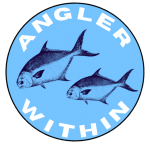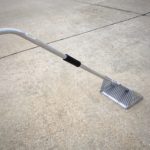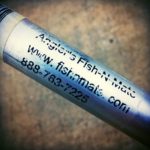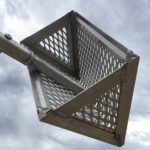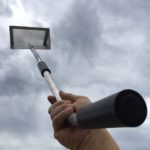Whiting, or “kingfish”, are some of the best fish to target from both Atlantic and Gulf coast beaches. In many areas they are available and easy to catch year round. Combine that with their excellent taste and you can see why they are a “go to” beach fish. Read on to see how you can successfully target the small but feisty whiting. I’ll hit on the following topics.
- General Info About Whiting
- Where To Find Them
- Tackle To Use
- Best Baits
- Tactics For Whiting
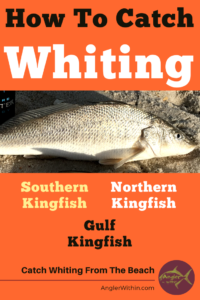
About Whiting
“Whiting”, which also go by many other nicknames, are actually three separate species of fish which are listed below.
Southern Kingfish (Menticirrhus americanus) aka Southern Kingcroaker
Northern Kingfish (Menticirrhus saxiatlis) aka Northern Kingcroaker
Gulf Kingfish (Menticirrhus littoralis)
It is typically easiest to distinguish between the three by their different colorations. Shown below, from top to bottom, are the Southern, Northern, then Gulf Kingfish.
#12DaysToFishmas We three kingfish of Chesapeake Bay come from all along the Atlantic to play. Meet the Chesapeake’s 3 species of kingfish: Northern, Southern and Gulf. @fishinvertlab pic.twitter.com/gw609waNwO
— SmithsonianEnv (@SmithsonianEnv) December 18, 2017
The word “whiting” is the most common designation for this trio of fish and thus is the focus of this article. However, you might find another nickname from the list below that’s more frequently used in your area.
Other Common Nicknames
- Ground Mullet
- Kingfish
- Sea Mullet
- Virginia Mullet
- Southern Kingfish
- Southern Whiting
- King Whiting
- Southern Kingcroaker
- Channel Mullet
Commonalities
All three species have the following things in common. They are all from the “croaker” or “drum” family of fishes which makes them close kin to the redfish and speckled trout. They can be found all along the gulf coast and up the eastern coast of the US all the way to the Chesapeake Bay area. They grow to about 12-20” (12” is more common) and typically weigh less than a pound. But, they can get over 2 pounds. All whiting are flattened on their undersides, with a sort of triangular body composition.
All 3 species prefer sandy or muddy bottoms in relatively shallow water (less than 30 feet). You will find them off beaches and near passes and inlets.
Whiting are a primarily bottom feeding fish with a down turned mouth and a chin barbel (whisker) that aids in detecting prey along the sea floor. So, you will want to keep your baits close to the bottom. They prefer to feed on small crustaceans of all types, including shrimp, crabs, clams, sand fleas, worms, etc. No doubt, this diet is part of what makes them so tasty.
Whiting are the best option for newbies, tourists or kids to cut their teeth on when trying their hand at beach fishing.
Some Whiting Facts
- Part of the "croaker" or "drum" family of fishes. (i.e. redfish, speckled trout, black drum)
- Range from the Northeast US down throughout the Gulf of Mexico and beyond
- 1/2 to 2 pounds
- 12-20"
- Have a chin barbel
- Prefer sandy or muddy bottoms in water less than 30 feet deep
- Love small crustaceans such as shrimp and crabs
- Commonly unregulated (be sure to check with your local state laws)
- Delicious tasting fish
Differences
Southern Kingfish
The southern kingfish, also known as the southern kingcroaker, is the most common of the three. It is also, in many places, commonly known as a ground mullet. It is darker than the gulf kingfish and can have indistinct vertical stripes – typically 7 or 8 of them. They do not have a dark splotch on the tail tip like gulf kingfish do. Their flesh is not quite as firm as the other two species. It is still quite good.
Record weight: 2 pounds 13 ounces
Gulf Kingfish
Also known as a kingcroaker, the gulf kingfish are the largest of the three whiting. The body is silvery in color and does not contain any vertical blotches or stripes like the other two species. It does, however, have a very noticeable black splotch at the top tip of the tail. I believe these are called sea mullet in North Carolina. They are lighter in color than the southern kingfish.
Record Weight: 3 pounds
Northern Kingfish
The northern kingfish is the least common of the three. This species has the vertical bars similar to the southern kingfish, but they are darker and more contrasted. It can be further identified by its long front spine of the dorsal fin which is not shared by the other two.
Record Weight: 2 pound, 7 ounces
Where To Find Whiting
All three species can pretty much be found in the same places and they all eat the same things. So, you fish for them all in the same ways. Typically the same species will be schooling together, but it’s quite possible to catch all three species in a single outing. Mostly I don’t pay that much attention to the particular species. If it’s an eating sized “whiting”, straight into the cooler it goes.
As previously mentioned, whiting have quite a large range and can be found in the northeast US, all the way around Florida and throughout the Gulf. As with many species, whiting migrate from offshore into the surf, nearshore, and even inshore areas for their annual springtime spawn. This is when they will be easiest to catch.
They live near the bottom and can be found within the various troughs located throughout the surf zone. You will have to explore the different beach troughs on a given day to find where they might be holding. The best place to start is in the first trough from the beach no matter how close that gut is. You would be surprised how close to the beach you can catch them. However, larger whiting do have a tendency to be slightly further out in deeper water.
In the summer months they will be really close to the beach, and in colder months you may have to cast further out to find them. But, there will almost always be some within casting distance. The best fishing will typically be during the spring spawn which will vary depending on where you are.
It’s best if you can find a section of beach with plenty of coquina clams and sand fleas. A stretch of beach such as this is typically going to hold more fish, and is where you should focus your efforts. Also, if you can find some water that looks different in some way, that is a good place to start. Maybe it has a little deeper area (darker water) or a cut through the sandbar where the current will be washing bait out to sea. Those are two great places to test your luck.
Regardless of where you start fishing, try different areas within the spot – try to find the “spot within the spot”. I like to start really close to the beach right in the first drop-off past where the waves are washing up. If you don’t catch fish there, or if they are too small, start trying other areas (further and further out and side to side).
If you fish an area of beach for a short while and don’t get bit, pack up and move down the beach. It’s also always an option to get back in your vehicle and drive to a completely different beach. You might have to do that a few times until you find the fish. Sometimes that’s what it takes to have a successful day fishing.
My focus is on fishing for whiting from the beach, as that is the most common place to target them. However, besides the surf, whiting can also be caught from piers and inside inlets. Since whiting can tolerate a wide range of salinity, they will even venture into passes and inshore waters regularly.
Note: Since whiting prefer sandy or muddy bottoms in less than 30 feet of water, don’t waste your time fishing in the wrong places – avoid really deep water, rocky bottoms, etc.
Best Tackle For Whiting
Rods And Reels For Whiting
The truth is, you can catch whiting on any sized tackle. However, to gain the most sport from the endeavor, I find it best to use medium light tackle, especially if you plan to hold the rod while fishing. Typically I don’t actually hold the rod, but rather I choose to use multiple rods positioned along the beach in sand spikes. That’s just my personal preference and you will have to find yours.
When holding the rod, a medium light rod with a fast action is your best option so as to help you detect subtle bites. But, one thing to keep in mind is that some days you are going to want to be able to cast a 1.5 to 3 ounce sinker. When surf conditions dictate that you should use a heavier sinker, that’s when you need a rod that can cast more weight. This is the reason I don’t typically go with a super light rod for the beach.
I prefer to use my 9-12 foot surf rods any time I’m beach fishing – even for whiting. A long rod helps me get the bait really far out when needed. Sometimes, such as in winter, whiting might be further out in deeper water. That is when a longer rod really shines. The longer rods also keep your line above any passing tourists and above crashing waves.
If you have further interest in the benefits of using a longer rod, you can find more about that in my surf rod article here.
As far as reels go, I’m not too picky as any reel will suffice. A 1500-5000 sized reel is a good range for general beach fishing. Smaller reels will be far more comfortable if you are going to be holding the rod and making casts all day. A common rule of thumb is to use a reel that can hold 200 yards of line in whatever pound test you choose. The reason for this is, if you make a very long cast and a big fish (redfish, black drum) were to hit your bait at the end of the cast, you still have enough line left on your spool to fight the fish. Finally, I prefer spinning reels for the beach, but i have used baitcasters as well. Use whatever you are comfortable with.
Line, Hooks and Leaders For Whiting
For the mainline, you should go with 8-15 pound mono or 10-20 pound braid. If you use braid, you will want to attach it to a mono or Flourocarbon leader using a small swivel.
Depending on surf conditions, I use from a 1 to 3 ounce pyramid weight combined with a 1/0 circle hook or smaller. I know some will recommend different types of hooks but i really like circle hooks for most saltwater fishing as you harm fewer fish that you throw back.
For leaders, I mostly use a two drop pompano rig but you could use a one drop or three drop as well. Sometimes i use beads (orange mostly), sometimes I don’t. The pompano rig keeps your baits slightly suspended off the bottom and out of the reach of crabs, but still low enough to be effective for whiting and other bottom feeding fish. It also reduces your encounters with stingrays. They are less inclined to pick up your bait if it’s not sitting right on the bottom.
I prefer 1/0 circle hooks because they are small enough for pompano and whiting but still plenty big enough to handle larger fish that might pick up my bait. You could definitely go even smaller on your hooks (#4, #6, etc) if you feel so inclined. Any way you go, you definitely want to be sure you have a small hook as that is key to hooking whiting since they do have very small mouths.
Use about a 24” leader with the first hook being 8-12” from the weight and the second hook being 8-12″ above that. See diagram below.

Best Baits For Whiting
It’s very important when fishing for whiting, that no matter what bait you use, to go with a small piece of bait on a small hook. That’s how you ensure they can get the bait inside their small mouths before they steal it.
Natural Bait Is Best
When possible, natural baits are going to be your best option. If you can find some really small live shrimp, that would be a great bait for whiting. However, most of the time live shrimp are going to be a tad too big and you might have to break them it into multiple baits. That’s OK, just make sure you have FRESH dead shrimp. Frozen shrimp does not work as well.
After shrimp, your next best option is to catch some small sand fleas from the waters edge and use those. You will need to purchase a sand flea rake for this, which you can obtain from a local sporting goods store, bait shop or online. I have purchased them in the past from wally world and Amazon. Below is the one that I am currently using. I purchased this one from Amazon and it works very well.
Finally, a couple other good natural bait options would be cut squid, small crabs and clams.
*Below is the sand flea rake that I use when gathering mole crabs.
*Natural bait options for whiting
- SMALL Fresh Live Shrimp
- Fresh Dead Peeled Shrimp
- SMALL Live Sand Fleas (Mole Crabs)
- Cut Squid
- Small Crabs
Artificial Bait Options
*Artificial baits that I use for whiting
- Fish bites (shrimp or sand flea flavors)
- Small pieces of Gulp baits
I would personally avoid using artificial baits other than a couple proven options. Those being Fishbites and small pieces of Gulp bait. I’m sure there are others that will work, but you can’t go wrong with these two. Whiting aren’t out there chasing down baitfish, so they aren’t going to hit lures as well as other species might.
A good option is to put a tiny piece of shrimp on your hook, accompanied by a tiny piece of Fishbites on the same hook. That way you have the best of both worlds. In case your shrimp gets stolen, the Fishbite is still working for you. Fishbites really shine when the bait stealers are roaming the surf. I never go to the beach without some.
Effective Tactics
Start Early
First and foremost, as with any fishing, I’m a huge believer in starting your day as early as possible. There is nothing like that first hour of light, especially on the beach. There is so much activity in the water’s edge as day is breaking, but it won’t last forever. It’s make or break time, and often times once the sun pops up, many fish move to slightly deeper water. So, to get a jump on the best fishing, I find it critical to have your stuff organized the night before and be ready to head out to the bait shop as soon as possible. If you can obtain your bait the day before, even better. Also, don’t forget to obtain a license ahead of time!
Rod And Bait Placement
Because I prefer long poles for beach fishing, I take my 9 to 12 foot surf rods (any length rod is fine) along with several sand spikes and spread them out 5-7 yards apart. Typically, I fish with up to 3 rods at a time. Any more than that and it feels like too much work.
I also find it most efficient to fish with 2 baits per rod by using 2 hook pompano rigs. The most obvious reason for 2 hooks is that it gives you a better shot at getting more bites. But, it also allows you to fish with several different types of baits and at different water depths at the same time. This helps you to more quickly dial into where the fish are holding and what they are eating that day. Finally, since the surf will be tugging at your line and masking bites, at least you have other baits in the water in case your bait was stolen by fish or crabs.
You will have to find your own preference, but the 2 hook pompano rig above, combined with a surf rod setup similar to the image below, is extremely effective for me. You can absolutely use a single rod to catch whiting – no doubt. If you use a single rod you would want to keep moving your bait around until you actually find the zone where they are holding. Whiting (and other fish) could be right next to the beach, beyond the first sandbar or as far out as you can cast.
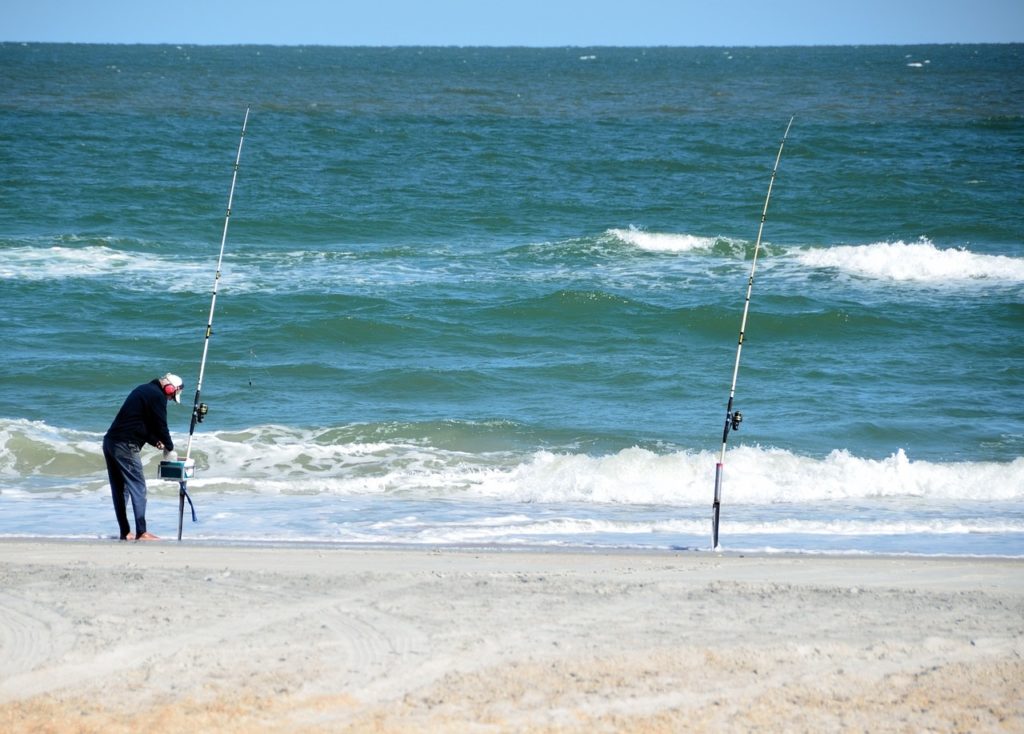
Bait Management
As already mentioned, it is key to use a small piece of bait in order to get more hookups. Because of this, it’s important to check your bait often, as it’s easy to miss your tiny bait getting stolen. A whiting bite won’t result in screaming drag or a doubled over rod, but instead will be a bouncing of the rod tip or a slack line. You will sometimes miss seeing the bite, especially in rough surf conditions. If you have gone more than 20 minutes, it’s time to reel in and see what the situation is.
My bait preferences are small pieces of fresh dead shrimp, live sand fleas or Fishbites. If I can catch sand fleas, I’ll put just enough to get me started in my pocket, and catch more as needed. I like to use all 3 of these bait options at the same time on multiple 2 hook bottom rigs.
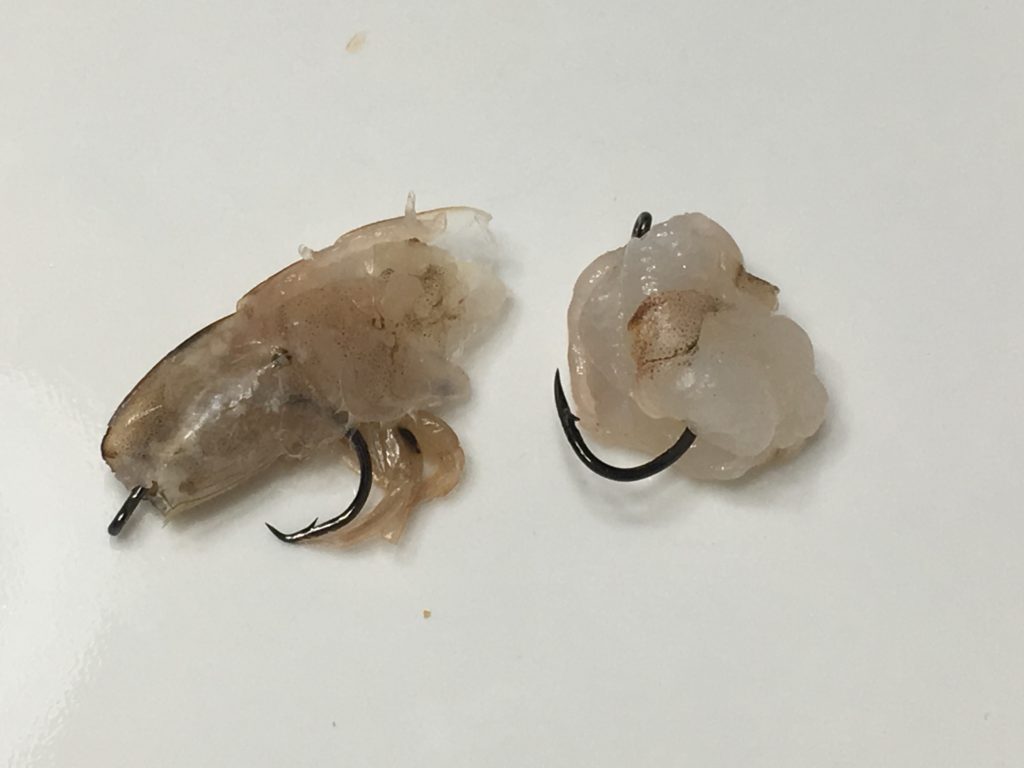
Seasonal Considerations - Trash Fish
Besides getting your setup right, the time of year is certainly going to have an impact on your odds of success. Two seasonal things immediately come to mind when trying to increase your chances at catching whiting. First, of course, is the annual spawn – more about that later. Second is “trash” fish, particularly THE HARDHEADS!
Hardhead catfish are a common species of saltwater catfish that, at times, will run so thick in the surf that it’s hard to catch anything else. This typically happens as summer nears. It’s not that the whiting won’t be out there, but it’s difficult to get them to bite before a hardhead takes your bait. It can be very frustrating to reel in hardhead after hardhead (or other trash fish), until you run out of bait and have nothing to show for it.
One way to increase your odds of catching whiting when trash fish are present is to use Fishbites instead of, or in addition to, shrimp. Fish Bites are an affordable and super tough bait. You can use the same bait for multiple caught fish and Fishbites will stay on the hook far better than natural baits. If small fish pick at your bait, they won’t be able to steal it before a larger fish has a chance to eat it.
I have also gone surf fishing before with nothing but Fishbites and done very well. They can be very effective.

Another way to try to get around trash fish is to simply change locations. By different location, I mean both different distances from the beach and also different beaches altogether.
As a final option, you could try to wait them out – try fishing another time of the day. You will often find that the catfish bite doesn’t last all day or at least will slow down at some point.
Seasonal Considerations - The Spawn
Whiting fishing can be outstanding during the annual spawn and lucky for us that can last quite a long time. Since the home range of the whiting is so widespread, the spawn could actually occur in almost any month, excluding maybe the dead of winter. You will have to check your specific region to determine when the peak spawn will likely occur. Even then, it can occur within a wide range, even for a specific area. In Mississippi, for example, the spawn can take place from March through October. The key to kicking things off seems to be when the water temps climb into the 50’s come springtime.
Generally speaking, the fishing will be best in the spring throughout the gulf coast region. However in some areas, such as Texas, whiting fishing can even be outstanding in winter. The reality is, unless you are in the northeast, you can target whiting most months of the year. And, even in the northeast, you can catch whiting all the way into the fall.
Conclusion
Whiting are some of the easiest edible fish to target from the beach, especially in the South. They are typically available year round, and once you figure them out, you can really load the cooler in a hurry.
Now, go out there and impress your family with a fresh kingfish dinner!
